To be precise, what I actually became was one member of a herd of semi-indentured servants under the direct supervision of some archaeologists.
But I was rolling the exact rocks, scrubbing the exact pottery, and digging the exact dirt at the Tell Keisan Excavation that Charles, my supervisor, directed me to, so by the transitive property, I guess I could say I was Charles. And Charles is an archaeologist. Therefore.
[4:05am] Wake up
Greetings from Lohame HaGeta’ot, a kibbutz located 127km north of Tel Aviv. In official terms, a kibbutz is a “collective community in Israel that was traditionally based on agriculture” (Google 2019).

Each morning, I engaged with our kibbutz’s bountiful traditional agricultural history by awakening to my roommate’s 4:05am iPhone alarm and sucking down an agricultural lungful of 47% oxygen, 44% cow poop, and 9% dirt.
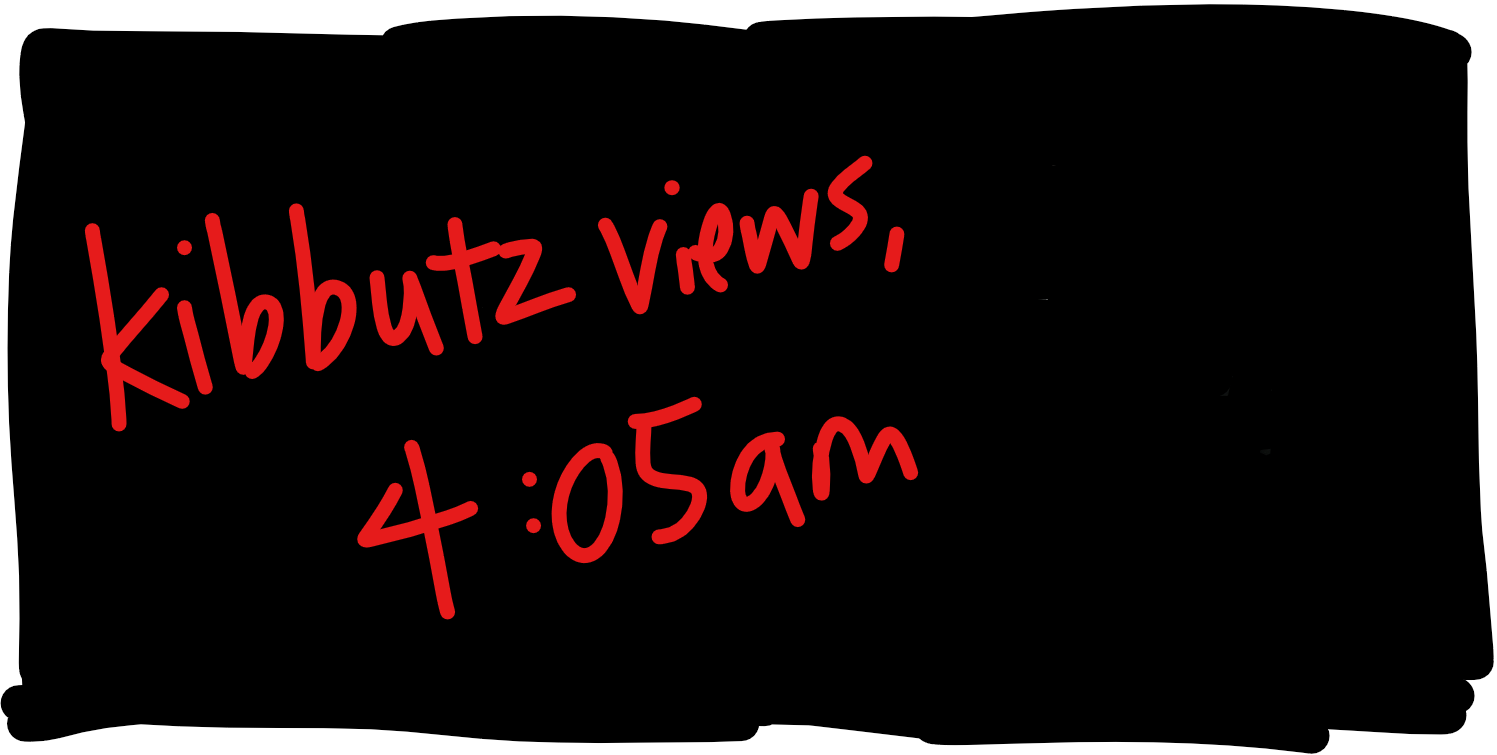
We lived 4-6 volunteer diggers per suite. Bunk beds, plastic cabinets, a teeny shared bathroom—a lot like a hostel. In the 4:05am pitch black, we stumbled past each other, into each other, and over each other to the shared bathroom, barely able to open our eyes in the way that newborn babies can barely open their eyes, on account of being so rudely shunted out of the womb, the womb in our case being the 6 hours of sleep we’d managed the night before, after we said with great determination “I am going to sleep at 8:45pm for real this time so I can finally feel healthy and well-rested for tomorrow’s 7 hours of intense manual labor” and then, like stupid fucking idiots, went to sleep at 10:00pm or later anyway.
My morning routine consisted of shoving my toothbrush back and forth a couple times along my molars, yanking my hair into a ponytail, and blindly slathering 5x the necessary amount of sunscreen in uneven swatches all over my semi-conscious body.

[4:30am] FIRST BREAKFAST!!!
There were maybe fifty of us. Between 4:30am and 4:53am, we trickled in to the common room and forced down as many calories as we could stomach in the form of sliced bread, soft apples, occasional bananas, hard-boiled eggs, coffee, and black tea. Some of us filled water cubes. All of us looked like dead people.
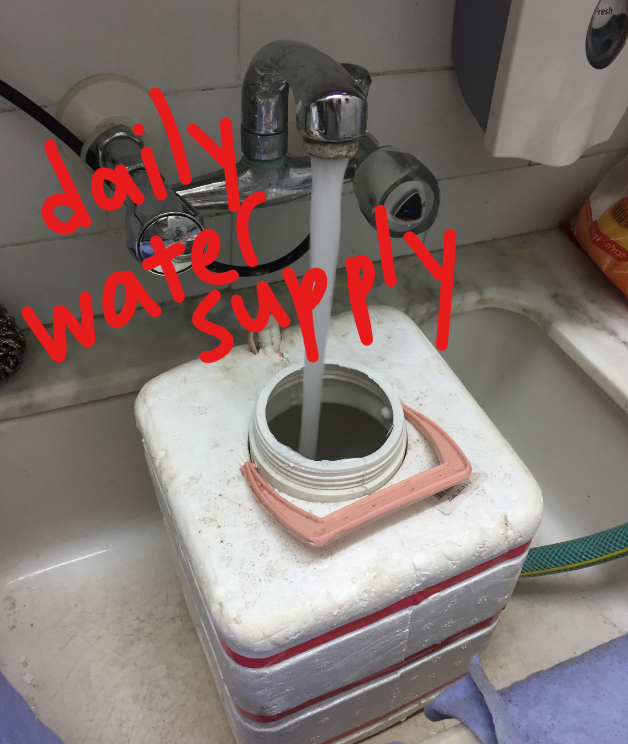
[4:55am] Bus to excavation site
At 4:54am sharp, a pack of international zombies groped/lumbered in sightless zigzags across the grass. Some of these zombies carried buckets or elevation equipment. Some carried cups of coffee or black tea with both hands, as one might carry the last remaining drops of potable water available on the planet Earth. It was all very apocalyptic.
[5:25am] Unroll the goddamn shade cloth
By 5:25am, the bus had turned off the highway, wound slowly and bumpily through a farming community, and dropped us off at the bottom of the tell. Recall that this dig is called the Tell Keisan Excavations. A tell is an “artificial mound, up to 30 meters high, formed from the accumulated remains of mudbricks and other refuse of generations of people living on the same site for hundreds or thousands of years” (Google 2019). In other words, it’s a fat cone with a flat top and bunch of history stuck inside.
At 5:25am, Tell Keisan looked like El Capitan. At 5:26am, climbing Tell Keisan felt like log-rolling up El Capitan in the middle of the Second Coming.
What proceeded was a circus. To protect ourselves from the ruthless Israeli sun, we had a massive shade cloth, about 20 meters by 30 meters, that filtered out about 70% of the UV. The problem was, each morning, we had to pitch the shade cloth, exactly as one might pitch a circus tent, with half the energy and double the confusion. Twelve-foot plastic poles were tied up at the edges of the cloth, plus sporadically in the center, and each morning, we stood two people per pole and, with some yelling and no legitimate coordination, wrenched the poles up and stuck them down into the ground.

This could be a full-body effort, if you were unlucky enough to be assigned to a pole located at a point of tension under the cloth. And let me tell you: it is a new and unique flavor of Upsetting to find oneself, at 5:30am, on the top of a big old mound of dirt, grabbing onto and desperately humping a tall orange pole as one’s stomach digests two plain refrigerated eggs, two slices of refrigerated bread, and 100mg of Lipton caffeine.
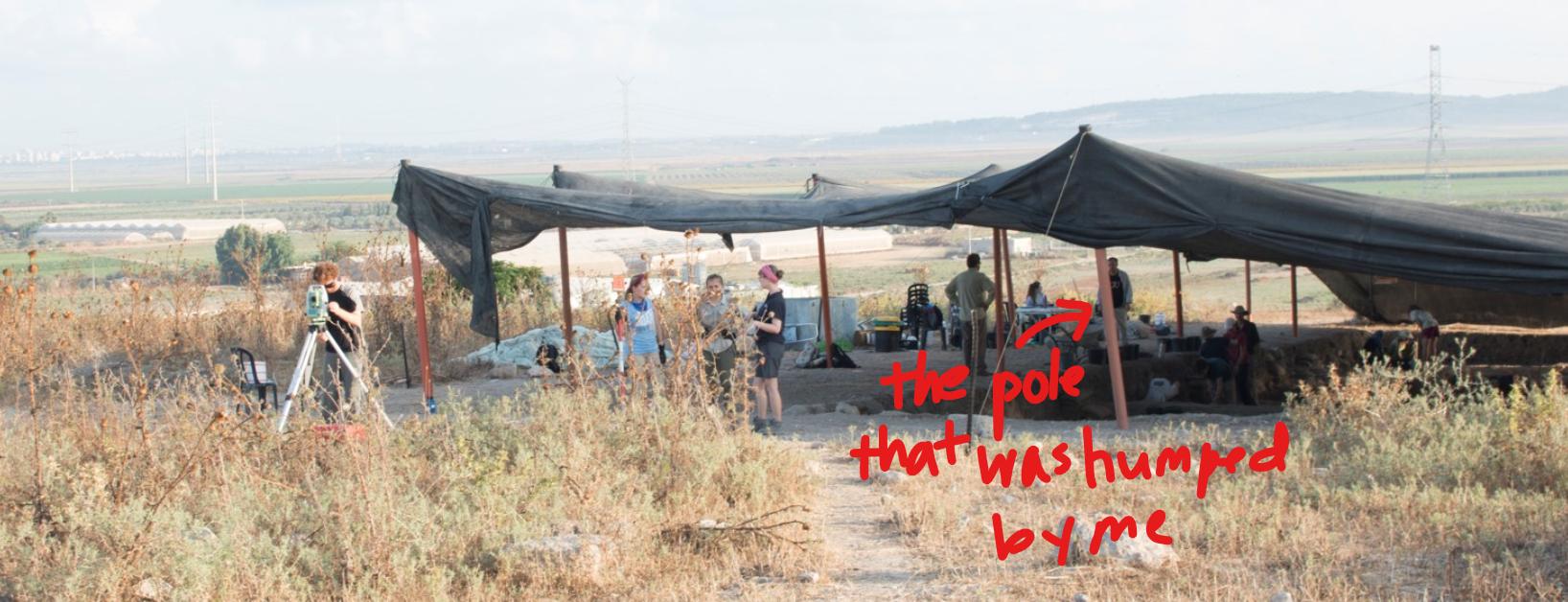
Overnight, we stored our equipment inside two huge, padlocked boxes at the edge of the site. After the pure human suffering which was the raising of the shade cloth, a representative from each square swarmed these boxes to compete passively and silently with representatives from other squares for the best, aka still-functional, equipment.
Archaeology terminology: sites are split into squares, which are typically 5×5 meters. Ours were 10×10 meters, for a reason the dig director gave on Day 1 which I instantaneously forgot.
Each square gets assigned a team, which includes a supervisor and a few diggers. The squares are separated by baulks, which are “strips of earth left between excavation trenches for the study of the complete stratigraphy of a site” (Google 2019).
Our squares became our homes during the day. Each square played its own music, had its own inside jokes, and naturally, developed its own internal dramas.

By 5:34am the sky was a watercolor pink and we were dropping hoes, pickaxes, buckets, wheelbarrows, trowels, brushes, and dustpans into said squares.
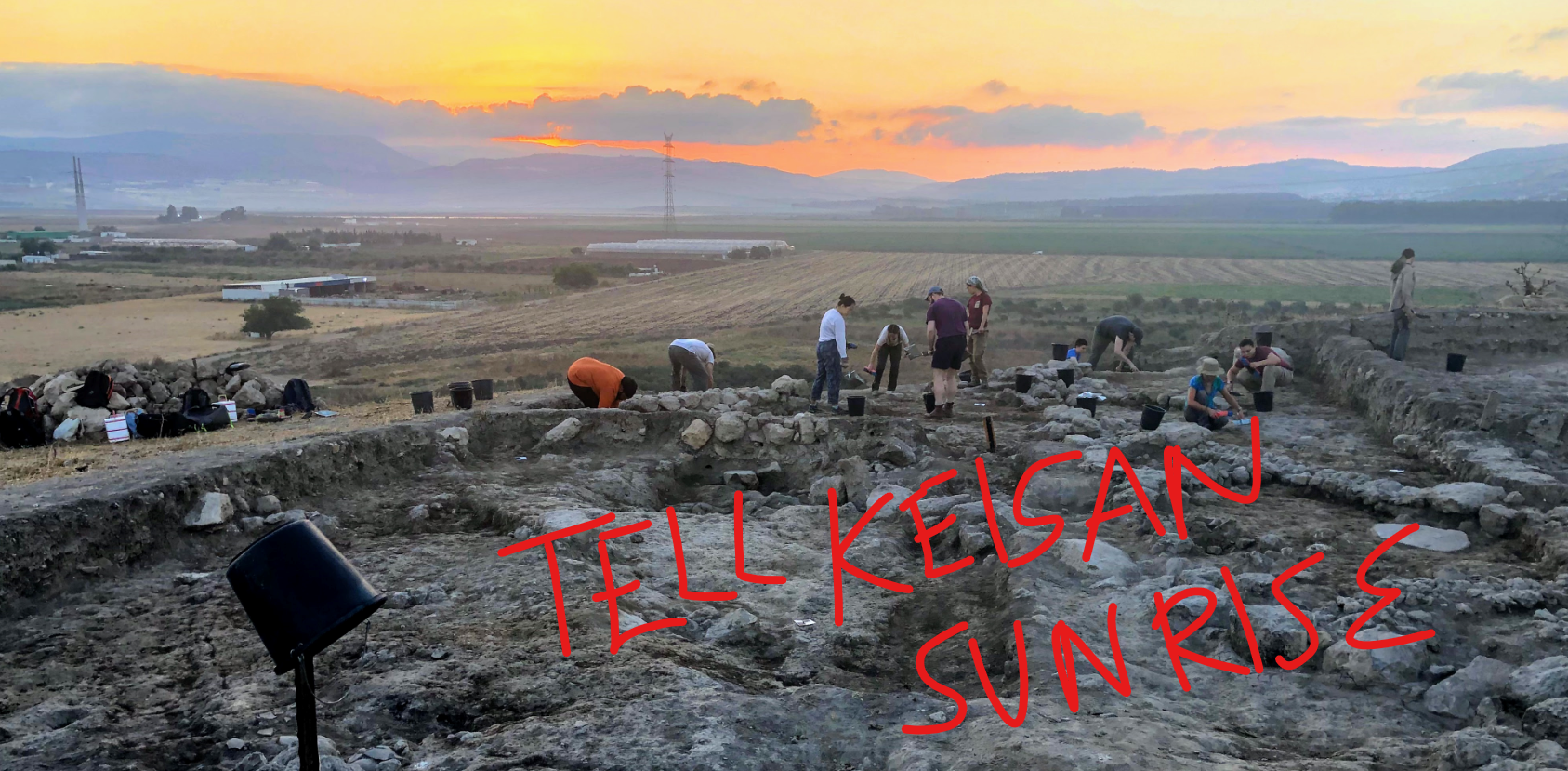
[5:30am] We dig dig dig dig dig dig dig for 3.5 hours
Bone specialists in wire-frame spectacles wandered Persian pits. Rows of volunteers scraped their trowels to reveal stratified dirt layers. Taboons emerged in crumbling orange from sherd-ridden dust. Drones whirred high above, grabbing details for 3D rendering.
My square supervisor crouched beside me and explained how to analyze stratigraphy:
- ashy dirt, which could mean a firepit,
- orange-brown dirt, which could mean a taboon,
- dust-brown dirt, which could mean something,
- pale-brown dirt, which could mean something else,
- dark-brown dirt, which could mean I tried to drink some water and missed,
- brown-brown dirt, which could mean something, again,
- dirt-brown dirt, which could mean something totally distinct from all the other somethings I just mentioned,
- packed dirt, which could mean a new surface layer,
- loose dirt, which could also mean a new surface layer,
- clay-like dirt, which could mean something exciting, and
- dough-like dirt, which could mean something [synonym of exciting].

Sometimes we dug fast, if we’d seen all we needed of one layer and were ready to move on. This was maniacal big-picking (there were big picks, or pickaxes, about 4 feet tall, and little picks, about 1.5 feet) and hoeing. Picks for breaking loose the dirt, hoes for scraping into buckets. This was shut-up-and-dig. This was you-should’ve-had-a-third-slice-of-bread-this-morning. This was good-thing-you’re-on-your-period-and-furious-with-your-boyfriend-because-how-else-would-you-decimate-a-whole-three-inch-thick-layer-of-dirt-off-a-10-meter-by-10-meter-square-in-a-mere-hour.
Other times, we dug slow, if our supervisor’s hand-drawn map hinted we might soon come across a new room or household appliance. Occasionally we stopped digging altogether and got out our trowels and stuck our faces in the dirt to do close-up work. This could be either sectioning, scraping the earth flat with the blades of our trowels in order to reveal stratigraphy, or articulating, using the points and blades to surgically remove dirt from fragile discoveries like an intact juglet, a clean line of loom weights, or mysteriously preserved…organic…remains (!!!!!).
Then, for the finest details, we used brushes and dustpans. Self-explanatory.

A majority of the dig was spent playing a game called ROCK, BONE, OR SHERD?! Here are the rules:
- Throw down your pick like Snow White’s yoked 8th dwarf
- Hear a CLONK or CLACK or PUK or WHAPOW
- Stoop down gingerly like an old man because that is exactly who you are after your first week on the dig; an OLD OLD MAN
- Salvage an object from the rubble
- Turns out rocks, bones, and pottery sherds are sometimes indistinguishable
- You could be holding a rock or a piece of 700 BC chicken drumstick
- Or a fragment of some ancient teacup that, when washed, will reveal groundbreaking secrets about the kingdom of Israel that directly alter every interpretation of the actual Bible
- Or, like, a fucking rock
Rock, bone, or sherd?

[9:00am] SECOND BREAKFAST!!!
I haven’t mentioned yet how much of this dig was actually just straight digging. Between 4:30am (First Breakfast) and 9:00am (Second Breakfast), I burned maybe 2,000 calories, squatting, jumping, and hacking away, plus lost maybe 3-5 pounds off my body and 1-2% off my soul via sweat. I suspect that by the time the field director called Second Breakfast, half of us were ready to eat the other half of us.
Like gobs of dirt smacked into clumps to form the vague shapes of human beings, we climbed/rolled/crawled out of our respective squares, tears/sweat pouring from our mud-slicked faces at the special sound of that sweet, sweet “Second Breakfast.” We each grabbed a dusty, dirty, muddy stool from nearby the equipment boxes and staggered in twos or threes to the olive grove, where we threw our stools to the ground and rinsed the dirt off our hands so we could line up at the table.
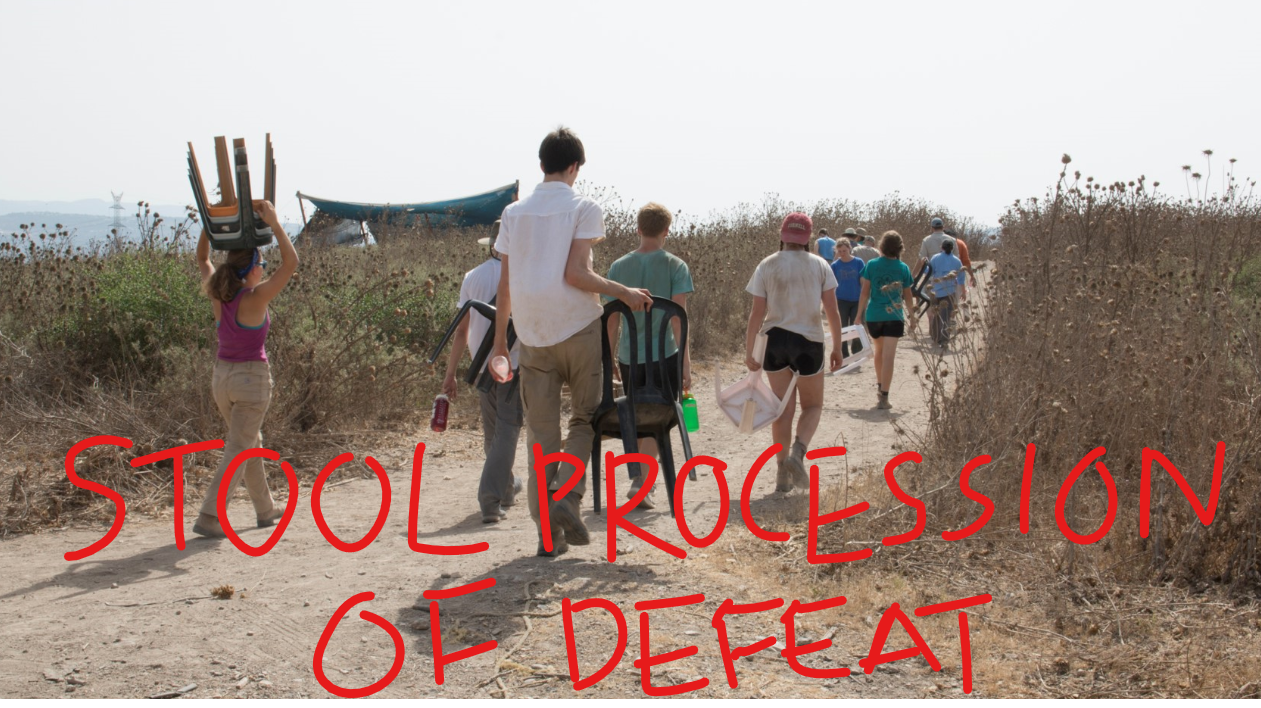
I cannot emphasize how much dust, dirt, and mud there was. If it was a light digging day, everyone had a sheen. A heavier day, and if you so much as brushed someone’s arm with your knuckle, you’d come away with a full millimeter of grime. You could have conducted a full stratigraphical analysis of each of our faces.
Second Breakfast was an ever-rotating cast of the exact same cast. AKA: Second Breakfast was the same food every day, except some days, some of it was missing.
Cottage cheese. Tuna. Peanut butter. Hard-boiled eggs. Tuna. Tomatoes. Cucumbers. Tuna. Yogurt. Tuna.
After Second Breakfast, we still had 3 hours of digging to go. Which, if we’re going by my calculations, would be another 1,714.285714285714 calories burned. We were all aware that we had to ingest 1,714.285714285714 calories within the 45-minute Second Breakfast block. Look again at the list of available foods on the Second Breakfast table.
I am lactose intolerant. In my mind, everything you just read meant that I had to violently mash AS MUCH TUNA (protein) AS POSSIBLE between two slices of bread. “But eggs are an excellent source of protein,” you say. “No,” I reply, “one must be extremely careful with one’s egg intake because, from a month working on a free-range egg farm, I now understand that it is simply good etiquette to limit one’s egg consumption, on account of potential noxious sulfurous chemically potent egg farts.”
I was told this once during my egg-farm orientation. I did not have to be told again. So, almost a year later, I took one look at the Second Breakfast table, and tuna it was. Tuna and peanut butter. Just grind it up and shove it down. Calories are calories.

[9:45am] We dig dig dig dig dig dig dig for 2 hours
Four archaeological tasks I haven’t yet covered:
(1) Bucket Duty
Dig dig dig dig dig dig dig => dirt dirt dirt dirt dirt dirt dirt.
Sorry, what is that, friends who worked at the dig with me? I still haven’t put enough dirt in this post to accurately dirt how much dirt dirt we dirt-dirt-dirted when we dirt dirt dirt dirt at dirt dirt dirt dirt dirt? DIRT DIRT DIRT DIRT DIRT DIRT DIRT DIRT DIRT DIRT DIRT DIRT DIRT DIRT DIRT DIRT DIRT DIRT DIRT DIRT DIRT DIRT DIRT DIRT DIRT DIRT DIRT DIRT DIRT DIRT DIRT DIRT DIRT DIRT DIRT DIRT DIRT DIRT DIRT DIRT DIRT DIRT DIRT DIRT DIRT DIRT DIRT DIRT DIRT DIRT DIRT DIRT DIRT DIRT DIRT DIRT DIRT DIRT DIRT DIRT DIRT DIRT DIRT DIRT DIRT DIRT DIRT DIRT DIRT DIRT DIRT DIRT DIRT DIRT DIRT DIRT
Here’s the deal: all that dirt had to go somewhere. Sure, we inadvertently ate some of it. But there was still a lot left. Hence: rotating bucket duty.
Each square had in its possession several rickety scraps of metal nailed together and supported by a thick wheel and two pegs. These were wheelbarrows. The Joyous ones picked the dirt and hoed it into buckets. The Other ones were on bucket duty with the wheelbarrows. Usually one or two people at once per square, these Other ones were in charge of dumping the filled buckets into the wheelbarrow and, once the wheelbarrow too was filled, manhandling it over to the edge of the tell and dumping it out down the sheer 30-something-meter cliff-face of a drop.
It was important to start manhandling the wheelbarrow toward the edge of the tell at a strategic time, because each bucket held some ~5-10 pounds of dirt, so each wheelbarrow, in turn, could hold maybe ~50-100 pounds of dirt. Plus boulders. Sometimes the Strong ones were called to lift a boulder the size of three grown men and the weight of a solid hunk of car, I think, and roll it—WHA-POW!!!—into a wheelbarrow.
Now, if you are dumping a wheelbarrow full of dirt/boulder off the edge of a 30-meter vertical drop, pivoting on a single rubber wheel, and the wheelbarrow weighs 100 pounds, what do you think will happen to you besides
you
will
plummet
off
the
side
of
tell
keisan
and
perish
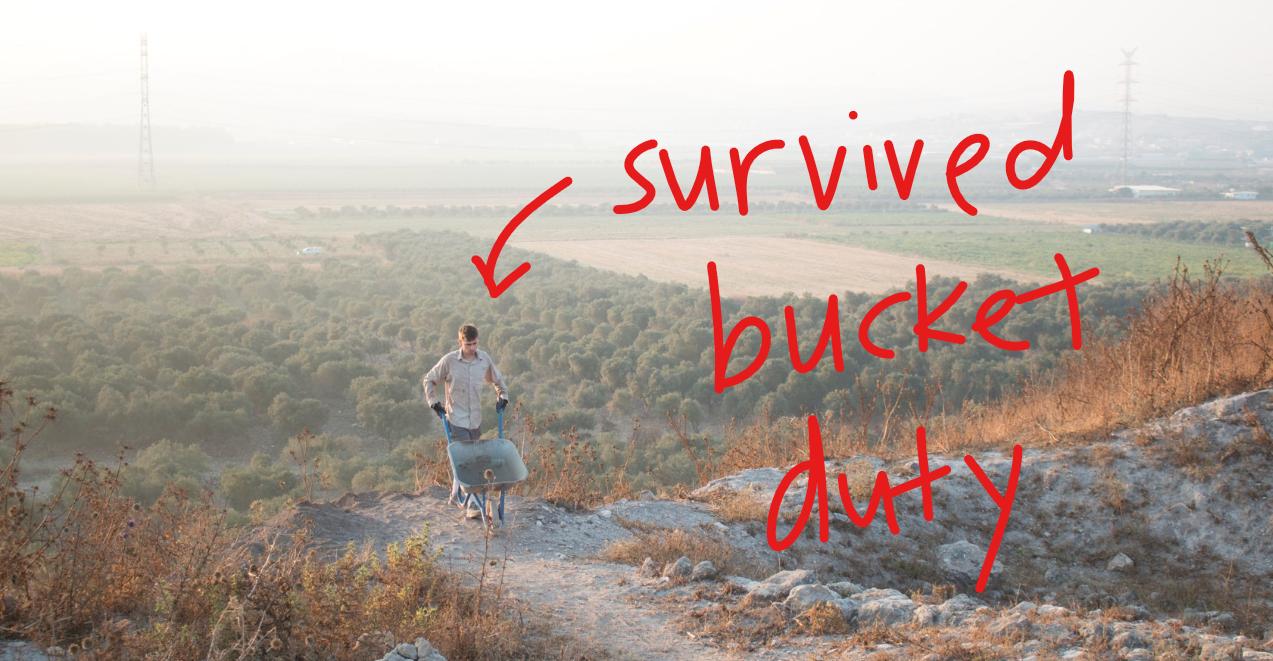
In short, it is a bad idea to let a wheelbarrow fill all the way, unless you are Charles or Eli, aka, deadlifters. But also, it is a bad idea to dump a wheelbarrow too soon, because (a) you will end up making too many trips out of the shade cloth and into the blazing heat during your bucket shift, and (b) you will be silently judged and determined a shrimp.
I never timed correctly. My pride was too strong and thus the wheelbarrow filled too far. Each visit to the edge of the tell, I first looked down to remind myself that I better be careful, and second looked up to wave at whichever Entity In The Sky might be observing me at the moment, i.e., “Kind Lord, it is I, your meek and humble servant Angela, I let the wheelbarrow fill too much again, could you please get your welcome mat ready.” And then I dumped the wheelbarrow and came face-to-face with Death Himself.
(2) Elevations
Because there was 3D mapping involved with the excavation, we logged x-y-z measurements periodically. For instance, each time we discovered a new artifact, like loom weights, we’d make an x-y-z measurement. We used fancy equipment. What kind of fancy equipment? How did it log elevation and location? Was it controlled by freaky alien magic because how else could such a simple setup log elevation and location without moving at all? Again, it was explained to me, but I instantaneously forgot.
What I can tell you is that there were two objects involved:
- A camcorder-looking object set up on a tripod, located at the edge of the site, and
- A cheap-looking webcam-ish object attached to a plastic stick, located in the hands of whoever was holding said plastic stick and moving it around according to the directions of whoever was standing behind the other camcorder tripod with a clipboard and yelling 20m across the site, “PATRICIA, COULD YOU MOVE PLEASE, YOUR HEAD IS BLOCKING MY VIEW”
If there are any real archaeologists reading this post: I am sorry.
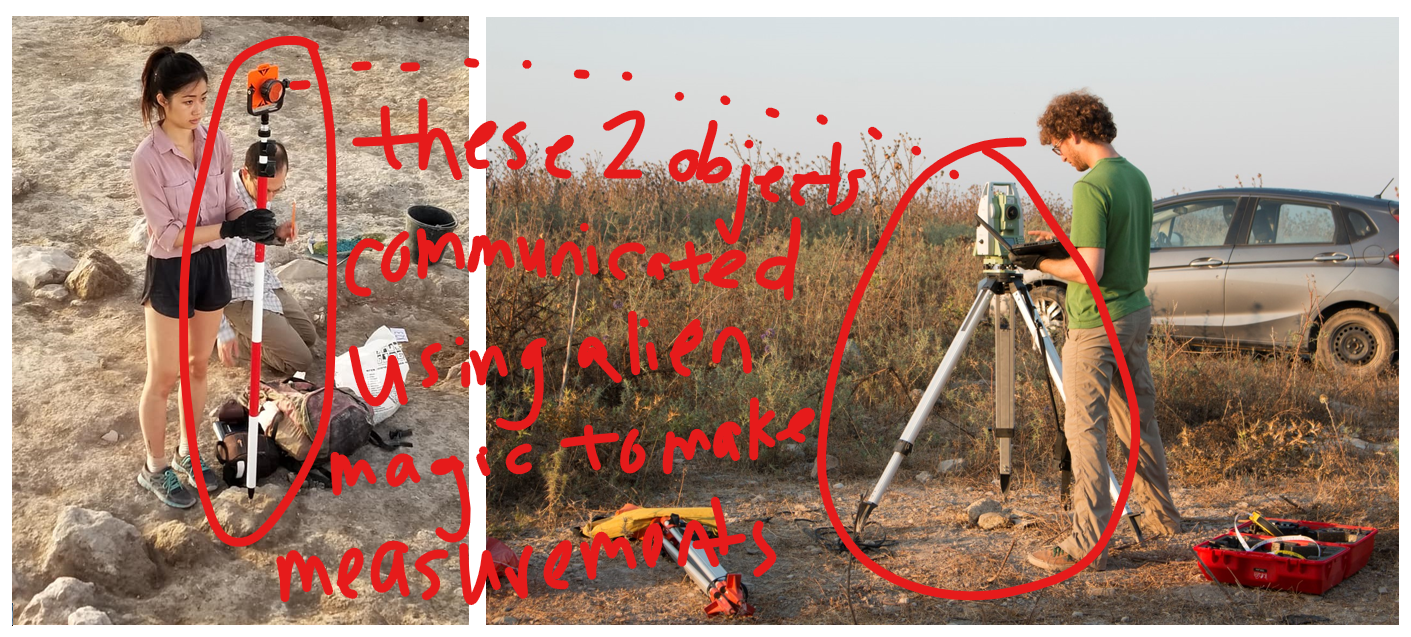
(3) Taking photos
Behind every artifact photo you see in an archaeology textbook is 3-15 dig participants balancing on dirt clods, rock formations, and sometimes, each other, holding up a variety of paper or sheets or towels to ensure consistent lighting.

[11:45am] FRUIT BREAK!!!
I was not a watermelon fan until the first day of the dig, when, at 11:45am, thirsty, dirty, homesick, in the near-100-degree blaze, I turned around and saw our field director and a handful of supervisors cutting open a watermelon. I heard the crunch from 20 meters away.
When it crunched, it said, “Angela.”
And I said back, “Yes, dearest, I am yours.”

[12:00pm] We dig dig dig dig dig dig dig for 1 hour
Example of a morning’s worth of labor:

Example of an afternoon find (a clay oven / taboon):


Another afternoon find (a near-intact loom weight):

[1:00pm] Bus back to kibbutz
Apt one-word summary of bus ride back to kibbutz:

[1:30pm] LUNCH!!!
I was perfectly delighted by the lunchtime offerings (miss you Taha!).
Others were not. For instance, one crewmate, a ballerina, exclusively ate small dollops of bread and chicken. She may have lost 50 pounds that summer if not for her schnitzel-hoarding habit, for occasionally the kitchen would produce a batch of schnitzels, and seeing them disappear handfuls at a time was our only proof that G wasn’t just gradually starving to death over the course of the dig.

[2:00pm] Shower and do laundry
The excavation shower is one of the top five most extraordinary experiences available to mankind. Because each time you enter that post-dig shower, you rediscover yourself—truly, deeply, thoroughly—in the most basic human way. Via post-dig shower, you emerge (from a cocoon of dirt, sweat, and sometimes insects that fell asleep in your hair and died there) as a fresh soul in a brand-new body.
Our dig administration were kind enough to organize a laundry service, with the caveat being that all the clothes that went into the communal laundry service came back in five big communal bags. To reclaim, say, your underwear, you had to paw through 10-15 other people’s underwear/shorts/socks/tank tops/towels. I, like most others, elected to wash my clothes in the sink, or scrub them in the shower. Then I hung them outside on whatever lines I could find. On dig days I went out to these lines at 4:06am, finding my way by bumping face-first from wall to wall, and retrieved them for use that day. On occasion, we’d have a windy night in the kibbutz, and in the pre-dawn I’d clutch blindly for my things before turning on my flashlight and seeing my poor underwears and socks and pants and bra scattered across the ground like dazed spirits wandering an eternal bardo, marked by the little footprints of the Entity in the Sky’s emissaries; in other words, night lizards.
On the topic of night lizards, one evening, a volunteer digger was strolling the kibbutz when she was chomped by a poisonous snake. That is not my story to tell. Fortunately, she recovered, and is now back in Brazil, continuing to be a vegan.
[3:30pm] Break
It was at this time that I would wander the kibbutz courtyards, hunting for WiFi so that I could call my boyfriend because I missed him. And, as it often turned out, because there was some long-forgotten minor issue, or recently-invented imaginary issue, that the distance and time zones between us morphed into an insurmountable incompatibility that I was simply required to argue out of my system while my Messenger dipped in and out of the feeble kibbutz WiFi so that, every other sentence, one of us would say, with a cold and mounting rage, “I can’t hear you, yOu CuT oFf, I diDn’T hEaR WHAT YOU SAID.”
I alternated this with respectable tasks like translating Chinese poetry and reading Moby Dick. With reading Moby Dick being the less respectable of the two, because much of it was a laborious, half-assed death march for me. So that whenever someone asked me how Moby Dick was going, I would reply, “I’m getting Moby DICKED.”
The parts I did enjoy were rather enjoyable, though.
I ought to take this opportunity to clarify that my boyfriend and I are, in fact, still together, after four years of him dealing with my steadily (but slowly) improving bullshit. Very grateful to him. Love him lots of much. But he will not appreciate this callback to my antics last summer, so let us pray that he has not read this far in this post.
If you have, Gabe, check inside your closet, I bought you a Sprite Zero and a pack of gummy bears, SURPRISE!!!!!!!!!!!
[4:30pm] Wash pottery for 1.5 hours
The proper terminology for a shard of prehistoric pottery is sherd. Why is it called a sherd and not a shard? Who knows. Apparently, British people made it up. In my opinion sherd invalidates the entire field of archaeology. Sherd. Turd. Sherd. Turd.
Essentially, each square sat around their buckets of finds from that day, along with a basket for clean sherds, with each square member in possession of a brush and a bucket of water. We scrubbed violently for 1.5 hours in hopes of finding evidence of written language. The closest we found were hash marks, which were potters’ ways of claiming their work.
One lecturer brought up an interesting point: ancient civilizations who kept records using “more advanced technology” (i.e., paper instead of stone tablets) are, present day, considered the “stupid” civilizations, since their paper disintegrated and now there is no evidence that they had a written language at all.

[6:00pm] Lecture
We were blessed with the presence of several professional archaeologists who gave such lectures as: “Recovery and Treatment of Animal Bone Remains” (Nimrod Miron), “The Excavation of Pottery” (Gunnar Lehmann), “OCHRE and Archaeology” (Sandra Schloen & Alex Ward), “The Southern Levant” (Leann Pace), “Daily Life in Ancient Israel” (Liz Bloch-Smith), “Clay Figurines in the Levant” (Barbara Bolognani), “Livestock Management in Galilee” (Nimrod Maron), “Comparative Geographies of Collective Memory” (Leann Pace & Jon Donald).
As you may expect, I have retained none of this knowledge in my brain. I did, however, take copious notes on the most exciting bits. If you want to know more, let me know in the comments.
[7:00pm] Dinner
[8:45pm] GTFTB (Get The Fuck To Bed)
I Always Think I Can Write a Short Post and Get On with my Life but Look Where We Are Now, and I Still Have More To Say
Portapotty: Ladies, imagine digging, sweating, and being on your period for three hours, and then going to poop in a portapotty that, while you were digging and sweating and being on your period for three hours, was sitting, door firmly shut, in the direct glare of the peak summer sun.
Dig Cold: All of us collectively inhaled/ingested enough 7th century dirt to form its own excavation site. Perhaps related, a sickness made multiple rounds within our ranks. At any given time, 25% of us were pale, trembling, snotty, and breathing in death rattles. And also still digging, so that the sickness could continue its iteration and move on to the next 25% of us.
Drone Photos: Once a week, we took drone photographs of the entire site. This meant we had to uncover the entire site. Which in turn meant we had to roll up the entire shade cloth. At this point, you may revisit the graphics I included of the shade cloth, do a double-take at the enormity of the task, and place your hand over your heart with a gentle gasp. All fifty of us lined up at one edge of the cloth and rolled the cloth as we clambered over baulks and maybe inadvertently stepped on and decimated important artifacts. Often, one side moved faster than the other, so that the supervisors stationed on either end would constantly be yelling, “STOP! NO! DON’T STOP! NO! STOP! NO! I MEANT START!” Then, once the shade cloth was out of the way, each of us grabbed a brush and dustpan and “dusted off the surface of the site,” which, if you have ever walked on earth, or looked at it, or in any other way interacted with it, you will realize is just dusting dust off of dust. It was the most excruciating labor, as we had to be careful to not leave footprints or bristle marks or even dust marks. It was during these moments that I inhaled the dust that clings to my lungs to this very day.
Refilling the Squares: At the end of the season, we partially refilled our squares, since the site would remain vacant for at least a year. This involved (1) saving up a bunch of dirt, (2) covering the squares with plastic, (3) getting in lines between the saved dirt and the empty squares, and (4) passing buckets full of dirt down the line, which (4a) was actually LOBBING them from person-to-person using momentum and SHEER VIOLENT CONFUSION, as (4b) supervisors screamed, (4bi) often in panic, and (4c) clouds of dirt whooshed up, (4ci) obscuring (4cii) all view of reality.

At the end of it all, a photograph of me and some loom weights I found made it into the Biblical Archaeology Review. I am carefully preserving this magazine so that I can one day tell my children, “Look, you ungrateful brats, I wasn’t always fat and hassled.”



—
Photo Credits: Alex Ward, Anne Wang, Hanna Pfeiffer


Hey Angela,
I’m not entirely sure how I got this blog post via email (I usually see them via fb), but I am glad I did. Reading about your dig was immensely fun.
I know you mentioned patreon before, but have you considered creating a newsletter and using substack? It’s this wild tech company that’s aiming at helping peeps start newsletters/blogs and get paid for it – https://substack.com/
They have this guide thing that seems relevant: https://on.substack.com/p/your-guide-to-going-paid
I’m in no way affiliated with it, just a fan of your work and a fan of substack
Best,
Mohammed
PS: if you have a free moment over the next little while, I’d love to chat and catch up 🙂
Sent from my iPhone
LikeLike
A true delight to open my email this morning and be just ~violently~ thrust back under to my life under the Israeli sun for a bit lmao!! Your writing is honestly amazing and I loved reading this! You truly captured the digs eau du dirt essence. Till next time we meet -P
LikeLike
Incredible write-up Angela! It really does make me feel like I’m back there again… it’s exactly how you say at the end: it felt ordinary in the moment but almost surreal now, like a dream. Even though it was tough getting up (or in my case, hah, not always managing to…) at 4am, and subsisting on peanut butter and off-brand Nutella, it was a memorable summer for sure. I’m impressed at how much detail you have here despite writing a year later!
My only small criticism is that this post needs more cats. 🐈🐈
I’m excited to see what else is coming up on your blog.
LikeLike
Hey Angela,
I loved reading this, reliving what our lives were like for a whole month. I didn’t even realize but you were also on the dig in 2019 which my dad and I attended. It was definitely a one in a lifetime experience that I will never forget about.
LikeLike
Kevin: thank you for reading. Indeed what an experience. I’ve been wanting to get on another dig soon. You were at Keisan in 2019?! Whose square?
LikeLike